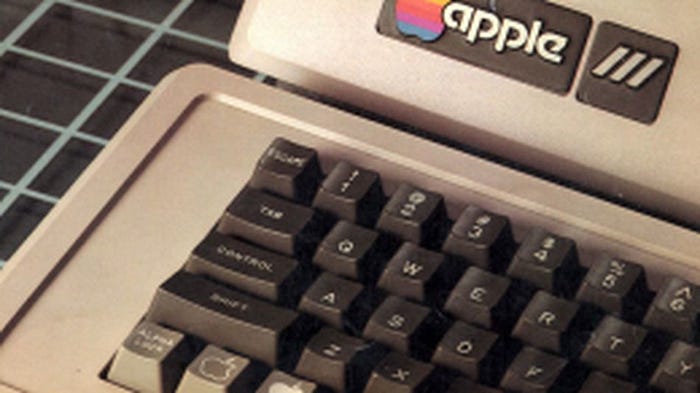10 Fascinating Facts You Didn’t Know About Apple

It can be argued that no consumer electronics company has captured the public’s fascination the way Apple has. Over the years it has morphed into more than just a company or corporation, but for many it has become a representation of a lifestyle or culture, and a status symbol complete with a larger fan base than most pop stars.
Here at Mashable, we’re also quite fascinated by Apple and its achievements. The company is known just as much for its veil of secrecy and ability to get the Internet buzzing with rumors, as it is for the actual products. You’re probably in on the gossip, but there are likely a few things you don’t know about Apple.
So read on for the origins of product names, factoids about the Apple logo, what Wozniak sold to finance the Apple I, and more wonders dug up from the archives of Apple’s past.
1. The First Apple Logo Featured Isaac Newton
Although the now-retro rainbow logo is arguably Apple’s most well known, the very first Apple logo featured Sir Isaac Newton sitting under a tree, with an apple about to hit his head. (Legend has it that he was literally hit on the head with an apple and that led to the concept of gravity.)
The Newton logo was designed by the lesser-known Apple founder Ronald Wayne (the guy who sold his stake — that today would be worth $22 billion — to Steve Jobs and Steve Wozniak for $800 — ouch!) and was only used briefly in 1976, since its high level of detail didn’t really show up that well when shrunk down and stuck on a product.
The rainbow apple, designed by Rob Janoff, replaced Sir Isaac and remained the symbol of the company for many years until the simpler monochromatic apple logo was introduced in 1998.
2. Wozniak Sold His Scientific Calculator to Raise Capital
In order to raise enough money to buy parts and build the first few orders of the Apple I, Steve Jobs sold his Volkswagen van and Wozniak, then an HP employee, sold his Hewlett-Packard 65 scientific calculator for $500.
Those born after 1990 might be surprised that a mere calculator would raise any kind of capital, but back in 1976, a scientific calculator cost as much as a laptop does today, and the HP-65 was in fact marketed as “the smallest programmable computer ever.”
Woz got a decent price considering it retailed for $795, and we imagine any calculator in his possession would have been more than fairly well used. We wonder if the buyer knew he was getting a piece of computing history — just imagine how much that calculator would fetch on eBay today.
3. The Apple I Cost $666.66
The high prices of Apple’s current computers have recently been among critics’ biggest complaints. But historically speaking, Apple products have always boasted a higher a price tag. In fact, when you account for inflation, back in the day, the very first Apple computer would have been more expensive than the MacBook Air or even a 17-inch MacBook Pro today.
The Apple I wasn’t priced at $666.66 with any Satanic connotations, but rather for more practical reasons, as Steve Wozniak once explained at a news conference:
“I was into repeating digits,” he said, and explained that the wholesale cost to stores was $500, and adding a third to get the retail price made it around $667, which Woz changed to all one repeating digit — $666.66 — “was just easier to type.”
4. Apple Invented the “Dogcow”
Ever heard of “Dogcow?” Early Apple users probably have, as she — yes she — was included in the Cairo font as part of the original Macintosh. After the Cairo font was discontinued, Dogcow lived on with LaserWriter Driver 4.0 and then became a sort of mascot for the Apple tech staff.
Designed by Susan Kare, Clarus — Dogcow’s given name — makes a “moof” sound and was found on all versions of the Mac operating system until OS X. In the late 1980s, she surged in popularity and started to be used by other developer groups — even Microsoft once used Dogcow in an advertisement.
As you could guess, Apple was none to fond of this, and the tech staff decided to write a Technical Note to stop the misuse. Later on, Technical Note #31 was included on the first Apple Developer CDs as an Easter egg, and Apple even registered trademarks for both Clarus the Dogcow, and her “moof” sound.
5. The Name “Macintosh” Was Inspired by an Apple
It’s often cited that the Apple Lisa was named after Steve Jobs’ daughter, but where did the name “Macintosh” come from? Apple employee Jef Raskin is responsible for coining the machine after his favorite variety of apple, smartly tying the whole fruit theme together.
Macintosh was just a code-name, and Steve Jobs is said to have tried to change the project’s name to “Bicycle” while the McIntosh-loving staffer was out of office. But Raskin clearly knew a good name when he coined it, as Macintosh just had too much staying power and stuck right to the end of the product cycle.
6. Apple Made the First Mass-Market Color Digital Camera
Back in 1994, Apple actually launched the first mass-market color digital camera in the U.S. The Apple QuickTake 100 could snap an amazing eight photographs and connected to a Mac via a serial cable.
It cost $749, which is about the equivalent of $1,000 today, which seems ridiculous for a camera boasting less than one megapixel resolution and no digital display.
The QuickTake line expanded to two more models before Steve Jobs shut it down in 1997 when he returned to the helm at Apple and streamlined its product line.
7. The Name “iPod” Was Inspired By 2001: A Space Odyssey
Clever copywriter Vinnie Chieco is credited with coming up with the iPod name as part of a team assembled by Jobs to create a consumer-friendly moniker for the new device.
The story goes that Jobs had already decided the MP3 player’s tag-line was to be “1,000 songs in your pocket,” which left naming options wide open since it wouldn’t have to explicitly refer something music related.
“As soon as I saw the white iPod, I thought 2001,” Chieco told Wired in 2006. “Open the pod bay door, Hal! Then it was just a matter of adding the ‘i’ prefix, as in ‘iMac.’”
Of course, Hal has another place in Apple history, in the sinister Y2K warning ad that Apple aired to advertise the fact that Macs would not implode with the whole 2000 switchover, unlike those pesky PCs people insisted on using. Oh wait…
8. The First iPod Had A Secret Easter Egg
Apple’s first iPod came with a little secret — an Easter egg — in the form of a game that could be accessed if you knew the right combination of buttons to press.
How to find the game is described in Nick Triano’s early 2002 Geek.com review of the iPod (memorable quote: “I don’t think it’s a stretch to say that it will change the way you listen to music”). “Go to the ‘About’ menu, hold down the center button for about three seconds, and you’ll get a Breakout (Pong) game to play while you listen.”
Breakout, the hidden game itself, is notable in Apple’s history as it was a product that both Steve Jobs and Steve Wozniak worked on together at Atari, where legend has it Jobs cheated Wozniak out of thousands of dollars of bonus money.
9. Who Is John Appleseed?
The name John, or Johnny Appleseed comes up time and time again in Apple history, but so far there is yet to be an official explanation as to why.
As many students will know, Johnny Appleseed was an 18th century American pioneer, missionary, and gardener. He was a kind-hearted folk hero with a penchant for apples, which appears to be the only tenuous connection to Apple Inc.
The earliest Johnny Appleseed reference we can find relates to Apple investor and former CEO Mike Markkula — it was apparently the pen-name he used when he wrote programs for the Apple II. Then there’s the letter that could be seen when the Leopard TextEdit icon was enlarged. Yes, there is an actual letter composed on that icon, and it’s Apple’s “Think Different” campaign that ran in print and television ads in 1997:
“Here’s to the crazy ones. The misfits. The rebels. The troublemakers. The round pegs in the square holes. The ones who see things differently. They’re not fond of rules. And they have no respect for the status quo. You can quote them, disagree with them, glorify or vilify them. About the only thing you can’t do is ignore them. Because they change things.”
That letter, is addressed to “Kate” and signed “Take Care, John Appleseed.”
And most notably, John Appleseed shows up in the iPhone ads and related iPhone and Mac imagery. We fully admit to being geeks, as we actually called John Appleseed’s number. Sadly, all we got on the other line was a voicemail box that hadn’t yet been set up, and when we e-mailed to appleseed_john@mac.com it came back with a “delivery to the following recipient failed permanently,” which seems like a missed marketing opportunity to us.
10. Jony Ive Sticks to the Same Shirt Too
Although much is made of Steve Jobs’ uniform outfit (black St. Croix turtle neck, Levi 501 jeans, New Balance trainers) it turns out he is not the only senior Apple staffer to stick to the same styling year in and year out.
Apple’s senior vice president of Industrial Design Jony Ive appears to have worn, if not the same, then the same style of t-shirt in every single Apple intro product video to date. For the last ten years, at least. Hey, we’re on the same page as Jobs and Ive on this style sheet — if it ain’t broke, don’t fix it.
More Apple resources from Mashable:
- Top 6 Free World Cup iPhone Apps — 10 Great iPhone Apps for Growing a Garden — 5 Fantastic Free iPhone E-book Reader Apps — 10 Essential Money-Saving iPhone Apps — 10 Fun Facts You Didn’t Know About Google
[Image credits: Apple advertising (main image, Apple I ad) — The MotherShip, McIntosh apple — Lars Zapf, Apple QuickTake — CNet]
Originally published at https://mashable.com on July 8, 2010.
